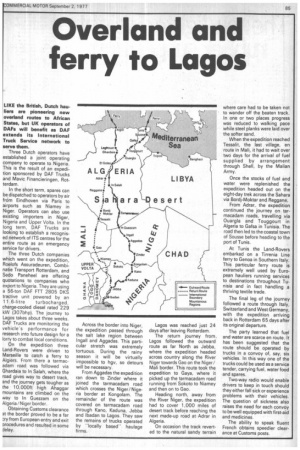Overland and ferry. to Lagos
Page 87

If you've noticed an error in this article please click here to report it so we can fix it.
LIKE the British, Dutch hauliers are pioneering new overland routes to African States, but UK operators of DAFs will benefit as DAF extends its International Truck Service network to serve them.
Three Dutch operators have established a joint operating company to operate to Nigeria. This is the result of an expedition sponsored by DAF Trucks and Mavic Financieringen, Rotterdam.
In the short term, spares can be dispatched to operators by air from Eindhoven via Paris to airports such as Niamey in Niger. Operators can also use existing importers in Niger, Nigeria and Upper Volta. In the long term, DAF Trucks are looking to establish a recognised network of ITS centres for the entire route as an emergency service for drivers.
The three Dutch companies which went on the expedition, Roelofs Assuradeuren, Combinatie Transport Rotterdam, and Sedo Paneheel are offering quotations to companies who export to Nigeria. They are using a 56-ton DAF FTT 2805 DKS tractive unit powered by an 11.6-litre turbocharged, charge-cooled diesel rated 229 kW (307bhp). The journey to Lagos takes about three weeks. DAF Trucks are monitoring the vehicle's performance for research into future design for a lorry to combat local conditions.
On the expedition three Land-Rovers were driven to Marseille to catch a ferry to Algiers. From there a tarmacadam road was followed via Ghardaia to In Salah, where the road gives way to desert track, and the journey gets tougher as the 10,000ft high Ahaggar mountains are climbed on the way to In Guezzam on the Algeria/Niger border.
Obtaining Customs clearance at the border proved to be a far ry from European entry and exit procedures and resulted in some Jelay. Across the border into Niger, the expedition passed through the salt lake region between Ingall and Aggadas. This particular stretch was extremely tortuous. During the rainy season it will be virtually impossible to hgv, so detours will be necessary.
From Aggadas the expedition ran down to Zinder where it joined the tarmacadam road which crosses the Niger/ Nigeria border at Kongolam. The remainder of the route was covered on tarmacadam road through Kano, Kaduna, Jebba and lbadan to Lagos. They saw the remains of trucks operated by "locally based" haulage firms. Lagos was reached just 24 days after leaving Rotterdam.
The return journey from, Lagos followed the outward route as far North as Jebba, where the expedition headed across country along the River Niger towards Gao on the Niger Mali border. This route took the expedition to Gaya, where it picked up the tarmacadam road running from Sokoto to Niamey and then on to Gao.
Heading north, away from the River Niger, the expedition had to cover 1,000 miles of desert track before reaching the next made-up road at Adrar in Algeria.
On occasion the track reverted to the natural sandy terrain where care had to be taken not to wander off the beaten track. In one or two places progress was reduced to walking pace while steel planks were laid over the softer sand.
When the expedition reached Tessalit, the last village, en route in Mali, it had to wait over two days for the arrival of fuel supplied by arrangement through Shell, by the Malian Army.
Once the stocks of fuel and water were replenished the expedition headed out on the eight-day trek across the Sahara via Bordj-Moktar and Reggane.
From Adrar, the expedition continued the journey on tarmacadam roads, travelling via Ouargla and Touggourt in Algeria to Gafsa in Tunisia. The road then led to the coastal town of Sousse before heading to the port of Tunis.
At Tunis the Land-Rovers embarked on a Tirrenia Line ferry to Genoa in Southern Italy. This particular ferry route is extremely well used by European hauliers running services to destinations throughout Tunisia and in fact handling a thriving textile trade.
The final leg of the journey followed a route through Italy, Switzerland and West Germany, with the expedition arriving back in Rotterdam 65 days after its original departure.
The party learned that fuel and water are scarce en route. It has been suggested that the route should be operated by trucks in a convoy of, say, six vehicles. In this way one of the trucks could be used as a service tender, carrying fuel, water food and spares.
Two-way radio would enable drivers to keep in touch should they either fall sick or experience problems with their vehicles. The question of sickness also raises the need for each convoy to be well equipped with first-aid and medicines.
The ability to speak fluent French obtains speedier clearance at Customs posts.




































































































































